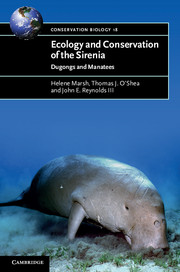Book contents
- Frontmatter
- Contents
- Foreword
- Preface
- Acknowledgements
- 1 Introduction
- 2 Steller’s sea cow
- 3 Affinities, origins and diversity of the Sirenia through time
- 4 Feeding biology
- 5 Behaviour and habitat use
- 6 Life history, reproductive biology and population dynamics
- 7 Threats
- 8 Conservation status
- 9 Conservation opportunities
- References
- List of online supplementary material
- Index
- Plate section
4 - Feeding biology
Published online by Cambridge University Press: 05 January 2012
- Frontmatter
- Contents
- Foreword
- Preface
- Acknowledgements
- 1 Introduction
- 2 Steller’s sea cow
- 3 Affinities, origins and diversity of the Sirenia through time
- 4 Feeding biology
- 5 Behaviour and habitat use
- 6 Life history, reproductive biology and population dynamics
- 7 Threats
- 8 Conservation status
- 9 Conservation opportunities
- References
- List of online supplementary material
- Index
- Plate section
Summary
The feeding biology of sirenians, the only group of fully aquatic herbivorous mammals, is arguably their most defining characteristic and the basis for their popular name – sea cows. In this chapter, we describe the feeding biology of wild populations of the four species of extant sirenians and the methods used to obtain this information. We then explore the significance of this information for sirenian conservation. We have not considered the feeding biology of captive sirenians, which is discussed by various authors, especially Best (1981) and Marshall et al. (1998, 2000, 2003), or the feeding biology of Steller’s sea cow and other extinct sirenians, which are discussed in Chapters 2 and 3.
Optimal Foraging Theory
MacArthur and Pianka (1966) and Emlen (1966) first articulated the theory of optimal foraging, which states that natural selection favours animals whose behavioural strategies maximise their net energy intake per unit time spent foraging. Foraging time includes both the time spent searching for food and the time spent handling food. The theory was devised to attempt to explain why, out of the wide range of foods available, animals often restrict themselves to a few preferred types. The theory is based on assumptions that may not apply to wild animals and is contentious (e.g. Pyke 1984; Pierce and Ollason 1987), but provides a useful heuristic framework for considering the trade-offs that sirenians have to make as they go about their daily lives.
- Type
- Chapter
- Information
- Ecology and Conservation of the SireniaDugongs and Manatees, pp. 79 - 144Publisher: Cambridge University PressPrint publication year: 2011
- 1
- Cited by



